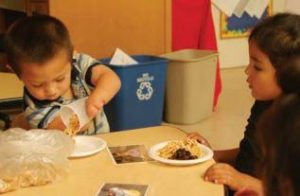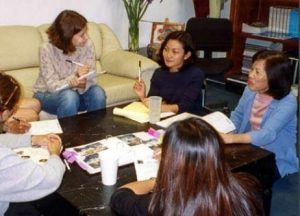7 What Programs Can Do To Be Inclusive of All Children
Most children identified by special education professionals as having a disability have delays in learning and communication (over 70 percent of children from birth to age 14). What is more important is that learning disabilities are often not recognized or identified until children begin formal schooling. Children who learn differently or have delays in language commonly manifest special needs through their behavior in group settings. Early childhood educators can provide a language-rich environment and make accommodations based on knowledge of the individual child.
Learning about Individual Children
Information about a specific disability may give an early childhood educator ideas for how to support a child. When serving an individual child, however, the provider should focus on the child’s needs, not the disability or its label. A child with cerebral palsy, for example, may walk with leg braces, use a wheelchair, have minor physical symptoms, or demonstrate a delay in using language. The possible variations within this one label are tremendous, demonstrating that no single label or diagnosis can provide enough information about a particular child. Early childhood educators need to learn beyond a textbook definition and ask questions with sensitivity and understanding—particularly in talks with parents.
Early childhood educators can go far toward setting a tone of welcome and understanding. When a family member shares a child’s diagnosis, a good follow-up question is often “And how does that affect ____________’s development?” This approach can help assure a family member that the child care provider is sincerely concerned about the success of the child and is interested in providing appropriate, individually tailored care. The response from the parent will help the child care provider determine what accommodations might be needed, what other questions may be appropriate to ask, and whether specialists are involved or needed.
Promoting Inclusive Practices
Even if children with disabilities are not currently enrolled in an early childhood education program, educators can still promote inclusive practices. One way is to have pictures, books, and materials that present children with disabilities in a general setting. How people are alike and different naturally arises in an early childhood education setting; a caregiver can take advantage of these opportunities to discuss them. Language use is also critical in developing an atmosphere of inclusion. The best practice is to use “person-first” language when one is talking about people with disabilities. This practice simply means putting the person before the disability: “a child with autism spectrum disorder” rather than “an autistic child.”
The process of exploring inclusion with families, colleagues, and children will suggest other ways to expand inclusive practices. For example, planning staff discussions on specific changes in philosophy, attitudes, and practices goes far toward including children with special needs in a child care setting. Outside the immediate early childhood education program setting, adults with disabilities in a community might contribute to a care provider’s expanding knowledge of issues related specifically to inclusion and to disabilities in general.
Successful Inclusion of Children with Special Needs
As each child is unique, so is each early childhood education program. There is no magic formula for making inclusion work beyond the creativity, energy, and interest that most early childhood educators already bring to their work. Their uniqueness notwithstanding, every program is able to successfully include children with disabilities. And each makes it work child by child, day by day. A “can-do” attitude among the teachers helps to provide the necessary energy for coming up with solutions to the inevitable challenges. It also helps to have an enthusiastic attitude on how to make inclusion work rather than to simply fulfill a legal obligation.
Some children need small changes to the curriculum or minor supports in order to get the most out of certain activities. These sorts of things may consist of fairly simple accommodations, such as providing a special place or quiet activity for a child who is unable to participate in large-group activities or making available a special snack for a child who needs to eat more frequently than the typical meal or snack schedule.

Other children may require more specific adaptations that might not be readily apparent. A variety of community resources can be helpful in determining what those might be. The family, for example, is always the first and most important guide for what a child might need; after that, an area specialist or a local workshop might be. Beyond the immediate community, a world of literature in books, periodicals, and Web sites devoted to disabilities and inclusion can inform an early childhood educator about appropriate adaptations for a child with a particular condition or need.
Programs that begin with a high-quality, developmentally appropriate foundation; a positive attitude on the part of the care provider; appropriate adult–child ratios; supportive administrators; and adequate training for the provider will be in a good position to creatively solve problems for a child with disabilities or other special needs, exactly as it does for children who are typically developing. If a child already has an established diagnosis, trained intervention personnel may be available to assist in this process. One of the biggest roles for a care provider is to facilitate a sense of belonging and inclusion. Several helpful strategies are as follows:
- Start with the assumption that all children are competent.
- Adapt the environment so that it is developmentally appropriate, challenging, and fits the needs and interests of each child.
- While there may be a need to support a child’s mastery of a specific skill, keep the whole child in mind, particularly the child’s social-emotional experience.
Consider the following questions when adapting an activity for a child with special needs :
- Does the child have an opportunity to be in control of the learning experience?
- Is there a balance between adult-initiated learning and child-initiated learning?
- Can the child make choices while learning the skill?
- Is the child able to initiate his/her own efforts to practice the skill, with support given by the child care provider?
- Is the child gaining self-confidence and showing the joy of accomplishment while learning?
- Is there room in the activity for the child to make discoveries?
Collaborating for Inclusion
To effectively meet the needs of children with differing abilities and learning characteristics, early childhood educators may need to expand the way in which they reach out to families and link with specialists. These two groups of people have important information to share and can serve as resources to support children in a program. Their suggestions invariably enrich efforts at inclusion. Specialists themselves may even be able to visit a care facility and offer some on-site guidance.

Providing inclusive early childhood education does not mean a teacher—or even a group of teachers—has to do the work alone. Everyone has a role to play. The primary role of an early childhood educator is to nurture and support the child’s development in a loving and caring manner. Partnerships formed with other adults who are caring for the child—the parents, health-care providers, or specialists—can complement the efforts of all concerned, especially when everyone concentrates on a particular strength. When the expertise of many are combined, ideas develop and strategies emerge that are better than those any one person could have developed alone. The result is the essence of true collaboration.
For collaboration to be successful, the following elements are essential:
- Respect for family’s knowledge and experience with the child. They are the first and best resource and should be included in planning and implemented care of their child.
- Clear and regular communication, both informal or planned meetings.
- Time reserved for collaboration, recognizing that everyone is likely going to be pressed for time.
- Everyone having an investment and active involvement.
- Collaborative efforts to provide the appropriate assessments and support services for the child.
Unit Attribution
Adapted from Families of Children with Special Needs or Special Health Care Needs in the open textbook The Role of Equity and Diversity in Early Childhood Education by Krischa Esquivel, Emily Elam, Jennifer Paris, & Maricela Tafoya. CC BY license.

